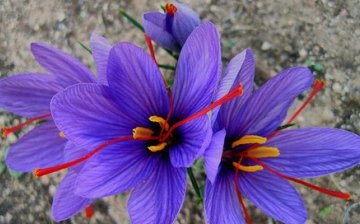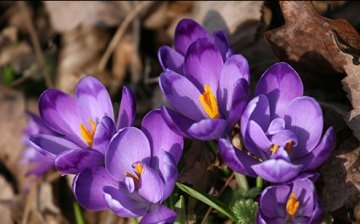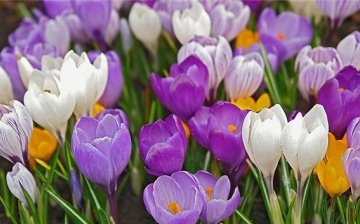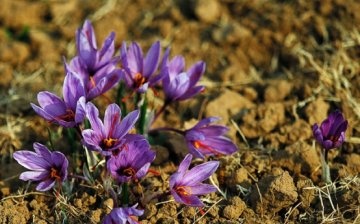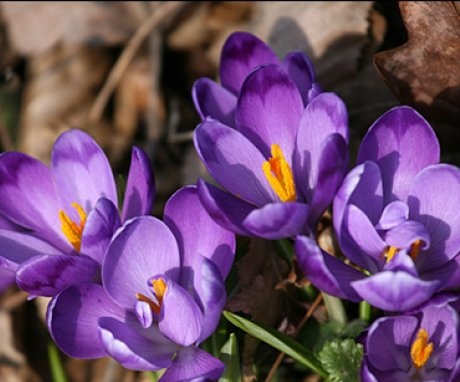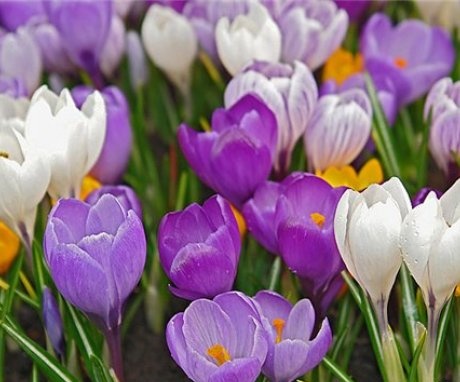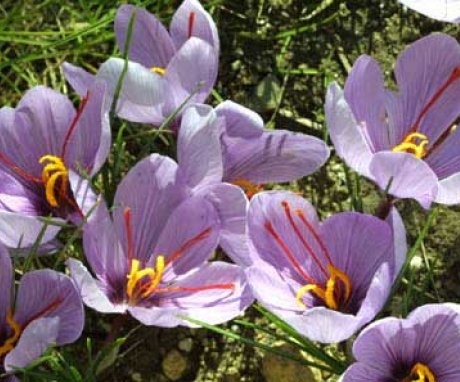How to grow saffron on your plot
Saffron is not only an attractive flower, but also a medicinal plant that is widely used in medicine. In addition, this plant is very often used in the food industry as a dye or spice.
Content:
Description of the plant
Saffron is perennialwhich has a height of 25 to 35 centimeters in height. It is characterized by the presence of a shortened stem and a funnel-shaped purple flower. The originality of the flower is given by an orange stigma, which is located on a short peduncle. The peduncle of this plant is wrapped in two or three leaves. The plant begins to bloom in early spring (in March-April). The corms of this plant are characterized by annual recovery. A new bulb appears on top of the old one every year.
Saffron is popularly called the monthly plant.
This is due to the fact that the rate of plant development directly depends on the number of lunar days. On one bush of this plant, as a rule, there is one purple flower. Sometimes there are flowers and white. Saffron develops most fully on fertile soil. Therefore, it is sometimes called a soil indicator.
Types of saffron
Today there are many varieties of saffron.
The most common ones include:
- Light yellow saffron (the flower-bearing of the plant is characterized by a yellow-orange color, and its diameter is 6-7 centimeters, and the plant begins to bloom in mid-April);
- Pallas (has a pink-violet flower stalk, which is characterized by a purple base and veins, and blooms in the second half of September);
- Reticulated (has a light purple flower stem, which is characterized by dark brown stripes on the outside, and blooms in the first half of April);
- Heufelliana saffron (the flower-bearing of the plant is characterized by a lilac, white or purple color, and its height is 10-20 centimeters, and the plant begins to bloom in mid-March-early April);
- Narrow-leaved saffron (the flower-bearing of the plant is characterized by a golden-yellow color, and its diameter is 4 centimeters, and the plant begins to bloom in the first half of April);
- Tomasini (has a flower-bearing of light purple color, which can smoothly turn into dark purple, and blooms in the first half of April);
- Suziat saffron (has a flower-bearing of golden yellow color, which is characterized by dark brown stripes on the outside, and blooms in the first half of April);
- Beautiful saffron (the flower-bearing of the plant is characterized by a lilac-purple color, its height is 10-12 centimeters, and the plant begins to bloom in mid-September);
- Golden-flowered saffron (has a yellow or blue flower stalk, which has a perianth diameter of 3-5 centimeters, and blooms in the first half of April);
- Geifel (has a purple flower stalk, which is characterized by dark spots on the top of the leaves, and blooms in the first half of April);
- Adams (has a flower-bearing of a golden-yellow color, which is characterized by the presence of a whitish or yellow throat, and blooms in the second half of April);
- Spring saffron (the flower-bearing of the plant is characterized by a white, purple or purple color, its height is 1-3 centimeters, and the plant begins to bloom in the second half of April);
- Banat saffron (characterized by the presence of funnel-shaped flowers with lilac stigmas, and the height of the peduncle is 12-14 centimeters);
- Alataevsky saffron (has a flower-bearing of dark purple color, which is characterized by the presence of a yellow throat, and blooms in early April);
Distinctive features of saffron varieties are the color of the flower, its size, as well as the flowering period. Basically, this plant is divided into two types: spring and autumn flowering.
Growing saffron
Growing saffron is difficult. This plant is quite demanding not only for soil, but also for climatic conditions.
Saffron does not tolerate shade, so it must be grown in well-lit areas:
- It is best to plant this plant in elevated areas that provide good drainage.
- When planting saffron, the soil should not be compacted.
- It should be loose and low in density.
- The best option would be loose soil, which is characterized by the presence of a sufficient amount of lime.
- In addition, saffron does not require absolutely no fertilizers.
- In the event that a high quality plant is required, the bulbs are planted deep into the ground. In the event that the gardener needs to obtain a high yield, the bulbs are planted closer to the surface, which contributes to the intensive growth of new bulbs.
- Most often, the bulbs are planted to a depth of 7-15 centimeters in June.
- In order to increase the yield of saffron threads, an interval between plants of 2-3 centimeters is maintained.
- When this plant is planted at a depth of 8-10 centimeters, you can significantly increase the yield of not only flowers, but also new bulbs.
These plants spend all summer dormant. They bloom only in early autumn.
Flowering is characterized by the presence of narrow leaves and buds. Harvesting saffron is difficult. Its flowers are capable of withering within one day, so they are collected very often (sometimes several times a day). It also complicates the harvesting process and the short flowering of the plant (one to two weeks). Saffron is enough frost-resistant plant, therefore, it is not worth covering and insulating it for the winter. This, on the contrary, can lead to the death of the plant.
Saffron propagation
The root system of this plant is quite simple. It has a bulb, which greatly simplifies the transplanting process. Saffron is transplanted and dividing its nests during summer dormancy, which falls on June-August (autumn-flowering varieties) or July-September (spring varieties). Saffron is propagated vegetatively. This plant must be replanted every 4-5 years. If you do not perform this action, it will lead to a decrease in the size of the corms and a decrease in the yield.
With a strong thickening of this plant, you can completely lose the crop.
Breeding tips:
- Initially, you need to dig up the corms, sort them and clean them of old scales and roots.
- Also, during this procedure, it is necessary to inspect the bulbs for the presence of diseases or pests.
- Bulbs affected by pests or diseases are not suitable for planting.
- Healthy bulbs are either planted immediately in the ground or left to dry in a warm, well-ventilated room.
- The planting of spring varieties of saffron must be done no later than the end of September, and autumn varieties no later than the end of August.
- Saffron is very easily propagated by daughter corms.
- Large corms are capable of forming a large number of babies.
- In order to increase the number of corms, it is necessary to make a shallow planting.
- Babies are able to bloom only 3-4 years after planting.
To maintain the purity of the variety, vegetative propagation is used.
Saffron is sometimes propagated and seeds... This method is of the highest quality for spring-flowering varieties. This is due to the fact that, unlike autumn-flowering varieties, they have enough time to fully ripen. It is best to sow freshly harvested seeds into the ground. Young plants bloom only 3-4 years after planting.
Plant diseases
Saffron is a fairly unpretentious plant, but at the same time it can carry some diseases. The most common diseases that affect saffron are rot and leaf rust. Also saffron is very often attacked by insects - rats, nematodes, birds, rabbits.
Leaf rust of plants caused by fungi:
- It spreads very quickly in conditions of high humidity, as well as when the temperature rises.
Also, this disease on saffron can appear as a result of excess nitrogen fertilizers.
- The first signs of this disease include the appearance of subtle light spots on the upper side of the leaf.
- After a few days, the spots can expand in diameter to a size of 5 millimeters.
- With this disease, white pustules may develop on the underside of the leaf.
- After full maturation of the pustules, they turn brown.
- After being affected by this disease, deformation, twisting and drying are noticed on the saffron leaves.
- After a while, the plant dies altogether.
If saffron is planted in an area with high humidity, then the disease spreads to flowers:
- It is characterized by the presence of necrotic spots of various sizes on the reed petals.
- The incubation period of this disease lasts from 14 to 60 days.
- At the first signs of this disease, it is necessary to treat the saffron with insecticides, and also remove the affected leaves so that rust does not spread.
To prevent this disease, it is necessary to ensure accurate watering of the plant.
Watering the saffron is necessary only at the root. You also need to avoid getting water on the leaves of this plant. In this case, it is necessary to carry out a regular examination of the saffron, and at the first manifestations of the disease remove diseased parts of the plant. The most effective insecticide in the fight against this disease is Bordeaux liquid, as well as a copper-soap mixture of vitriol.
Rot is characterized by:
- The appearance of spots on the plant, which over time become more and more, which leads to the fall off of the leaves.
- The spots can have a variety of colors - dark gray, red-brown, brown.
- When this disease spreads, the saffron leaves dry up and fall off.
- Also, rot can spread on the stalk of the plant, which leads to its falling off.
This disease can spread very quickly, therefore, when its first signs appear, it is necessary to immediately begin to eliminate it. In order to prevent this disease, it is necessary to decontaminate the saffron bulbs during planting. Planting bulbs close to each other is also not worth it, as this can lead to plant decay. If the saffron is planted rarely enough, then it will be very well ventilated, which will ensure that it cannot be infected with the disease. Also, to prevent rot, it is necessary to feed this plant with phosphorus and potassium in small amounts, but you should not overfeed it with nitrogen.
To combat this disease, Bordeaux liquid or ash is used.
In order to limit the saffron from attack by various rodents, you can treat it with insecticides.But after that, the leaves and flowers of the plant cannot be used for medicinal purposes. That is why a variety of scarers are very often used to combat rodents.
With proper care of saffron, it will not be affected by various diseases. Therefore, the plant needs to provide fertile soil, a sunny place, as well as moderate watering. This will not only limit the possibility of a variety of diseases, but will also significantly increase the yield of saffron.
More information can be found in the video.



